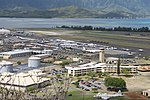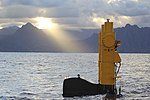Kapapa Island
Hawaii geography stubsHistoric districts on the National Register of Historic Places in HawaiiIslands of HawaiiNRHP infobox with nocatNational Register of Historic Places in Honolulu County, Hawaii ... and 2 more
Protected areas of OahuUse mdy dates from August 2023
Kapapa Island is a flat, uninhabited island in the Hawaiian archipelago in the Pacific Ocean. It is located in Kāne'ohe Bay about two kilometers off the east coast of the island of O'ahu. Kapapa was used as a place of worship by Ancient Hawaiians, and contains a heiau. It was included as Kapapa Island Complex and Historic District in the National Register of Historic Places. Beginning in 1917, the island's wildlife resources have been protected. In 1932 a wildlife reservation executive order was issued, and in 2010, the Department of Land and Natural Resources announced it would be protected by rule as a wildlife sanctuary.
Excerpt from the Wikipedia article Kapapa Island (License: CC BY-SA 3.0, Authors).Kapapa Island
Geographical coordinates (GPS) Address Nearby Places Show on map
Geographical coordinates (GPS)
| Latitude | Longitude |
|---|---|
| N 21.476944444444 ° | E -157.79861111111 ° |
Address
Honolulu County
Hawaii, United States
Open on Google Maps










